Deconstruction of Taptap Heroes: disassembling a hybrid of a clicker and a buttler
On May 18, Taptap Heroes was released worldwide on Google Play. Formally, this is a clicker with a collectible card meta, which is distinguished by a high product value and a number of interesting developments. Since its release, its daily revenue on the Android platform has grown from $ 5 to $ 10 thousand.
Hybrid model
I borrowed the term “hybrid” from Adam Telfer. He used it to describe a project that takes a group of solutions for one popular game and implements them within a non-standard gameplay for them. We are not talking about the transfer of several elements, but about a larger integration.
The hybrid approach to development cannot yet be called popular. Its brightest representatives earn well, but they are not unambiguous leaders. Nevertheless, they look much more interesting than the bulk of products on the market and not only open up new niches, but also develop those genres whose features they combine.
Some of the most successful hybrids are Golf Clash and Empires & Puzzles. We recently wrote about the first one. This is a mix of an arcade golf simulator and Clash Royale, from which the Playdemic development team borrowed meta.

Golf Clash
As for Empires & Puzzles, this is the creation of the Finnish team Small Giant Games. She combined an Asian match-battler and a strategy in the spirit of Game of War in her game.
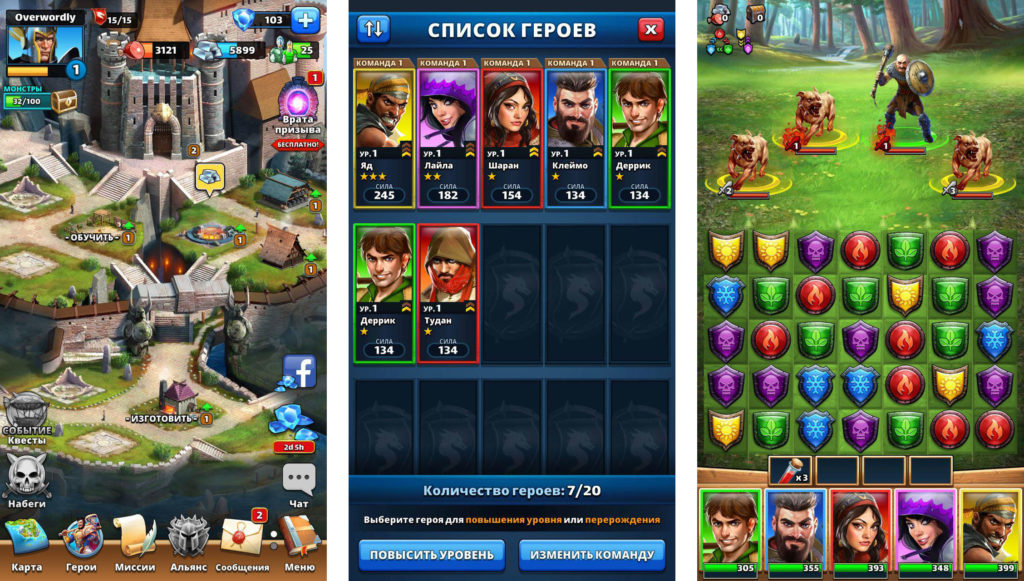
Empires & Puzzles
The first project earns more than $ 10 million a month, the second — about $ 8 million.
Despite the “hybrid breakthroughs” that occur, many teams in the market still prefer to clone successful projects rather than take a more creative approach to development. It gets ridiculous when some companies adopt approaches and mechanics that big companies refuse. For example, in 2015, Supercell closed the Smash Land project that never came out of the softlonch. This did not stop a number of teams that operate with her clones today.
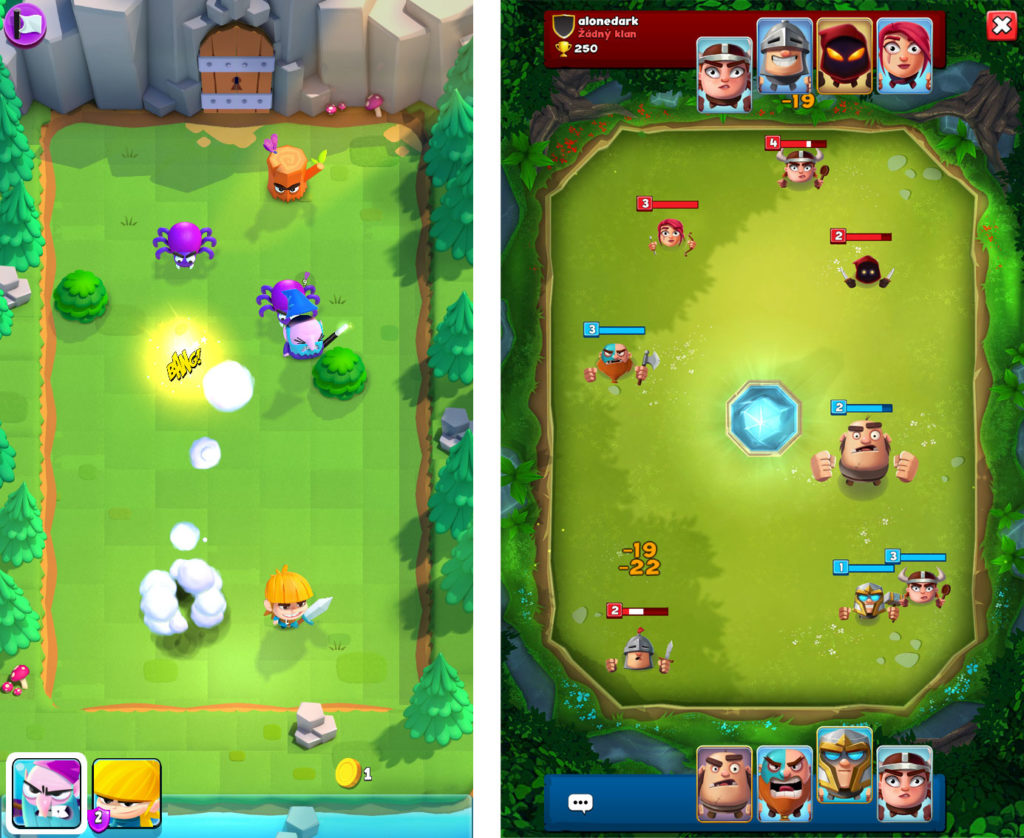
Smash Land and Smashing Four
The fact that cloning prevails over the hybrid approach can be understood. But along with the reduction of potential risks, the teams that took up the creation of the project “according to proven patterns” are limited in growth. With very rare exceptions, a clone can become more successful than the original.
The advantage of a hybrid over a clone is that, although it takes unoriginal and already used mechanics, but their layout and interaction — with the same high level of recognition — cause new emotions and interest in the target audience.
Taptap Heroes — clone and historically conditioned hybrid
Taptap Heroes is one of the hybrid games. It combines the popular mechanics of a combat clicker * with elements of a collectible battler**.
* Here and further, the clicker refers to a genre called in English Incremental game or idle games, that is, games that require performing the simplest repetitive actions to earn in-game currency. For example, a click. It so happened that today the genre is moving away from its basic mechanics. Its secondary features come out in the first place: automatic currency earnings, pumping of game entities, accelerating currency generation, and so on. Classic examples of clickers: Cookie Clicker, AdVenture Capitalist, Candy Box.
**Collectible Battler (not to be confused with CCG/TCG) is a game in which the main gameplay is formal. The game progress is primarily influenced not by how the player showed himself in the fight, but by what collection of fighters he collected within the meta, how much he pumped them. Classic battlers: Heroes Charge, Blood Brothers, Rage of Bahamut.
The key difference between Taptap Heroes and the hybrids already mentioned above is that such a mix is not an exceptional and unexpected solution, but an evolutionary step for genres.
Initially, clickers were primarily devoted to construction topics. The user called up resources, invested them in the construction of factories so that they could generate resources for him faster than he clicks on the device screen.
The situation on the market was changed by the appearance of Clicker Heroes. In the Playsaurus studio project, the player bought and improved not factories, but heroes who fought monsters. The more heroes there were and the stronger they were, the more game gold the player received. Thanks to Clicker Heroes, idle mechanics began to be perceived, among other things, as combat.

Clicker Heroes
The next development step for the genre was Tap Titans from Game Hive. The Canadian development changed the visual format of the feed, introduced a main character with whom the player could personify himself, inventory, and also brought this direction of clickers to mobile. Clicker Heroes appeared in mobile stores only a year after the release of Tap Titans.

Tap Titans
Almost a Hero went even further. The project left the basic mechanics, but limited the number of heroes fighting monsters, made a unique skill tree for each of them, thereby bringing the game closer to the role-playing direction, and also introduced events and rings that affect the type of click strike.

Almost a Hero
On the part of the battlers, there was a mutual movement towards the clickers. At a certain stage in collectible battlers, combat mechanics become superfluous, it is perceived as routine, because the main thing is pumping and the results that it brings. Its automation would reduce the irritation from the grind.
Idle Heroes, the buttler of the Chinese studio DH Games, was one of the first to move in this direction. On the one hand, he did not completely solve the problem with routine. The player still had to complete missions “in manual mode” (independently launch battles, wait for them to end, click on pop-up windows with information about its results). However, auto-farm mechanics were introduced into the game. Without the player’s participation, the squad could automatically fight enemies from the completed mission, earning resources.
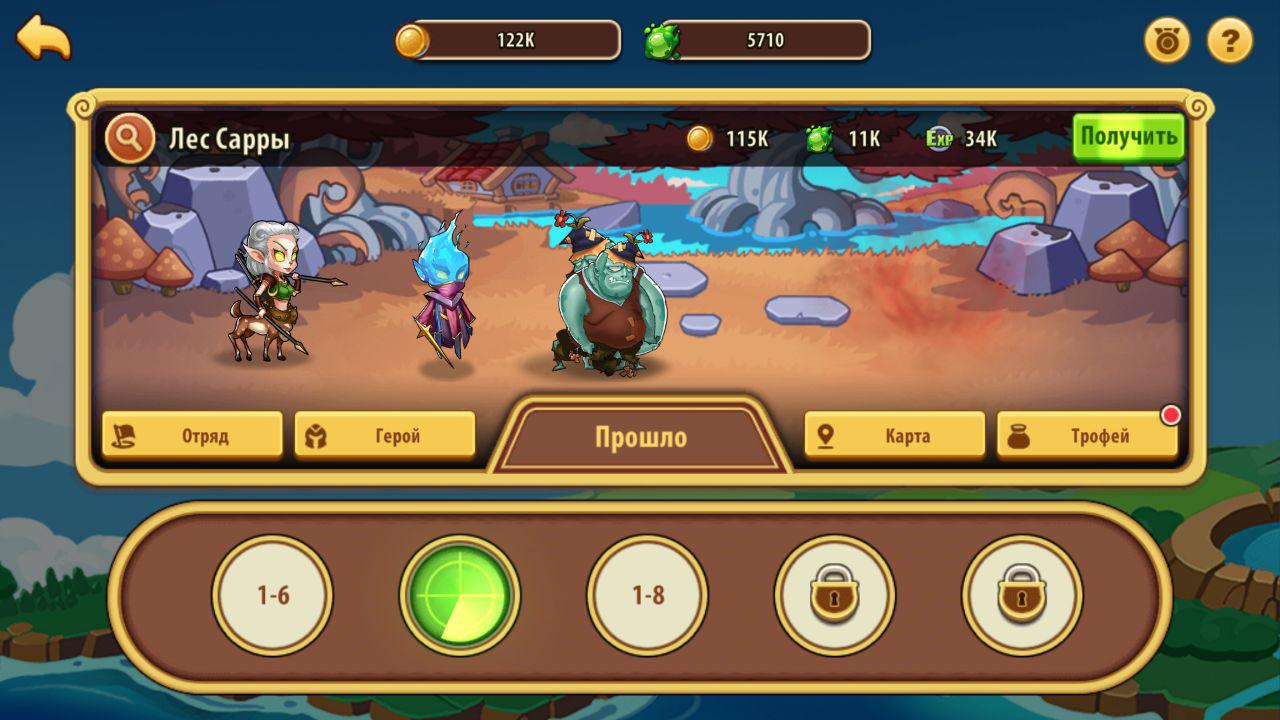
Idle Heroes
It seems logical that after years of mutual integration, a game should have appeared that equally combines the mechanics of both directions, finds a balance. With great reservations, such a game can be called Taptap Heroes.
I mentioned the reservations for a reason. Taptap Heroes is both a hybrid and in many aspects a clone of the Idle Heroes just mentioned. A large number of features and mechanics, which I will mention below regarding Taptap Heroes, were first implemented in Idle Heroes, which now earns $11 million per month.
The peculiarity and importance of Taptap Heroes is that it boldly builds a bridge between genres. While Idle Heroes clung to the battler legacy from the point of view of UI, UX, graphic stylistics, Taptap Heroes refuses genre decisions in these moments and no longer flirts, but directly appeals to clickers, although it does not make any revolutions within the game logic.
The essence and main cycle of Taptap Heroes
In the project, the player pumps his team, consisting of heroes of various rarity.
Pumping heroes is not tied to the experience gained or the number of fights passed, but to the funds spent on them (game currencies and items).
Currencies and items for pumping go into the player’s pocket from three main sources: grind, additional modes and daily tasks.

Taptap Heroes Game Cycle
Pumping allows you to defeat more and more powerful enemies and pass on, which — attention — allows you to increase the amount of currency received per unit of time.
Basic mechanics
At first, the earning of resources takes place within the framework of the main game mechanics — automatic combat. He just has a project in common with clickers.
The implementation of the battle visually resembles Almost a Hero: two squads are located opposite each other on the screen. One belongs to the user, the second belongs to the opponent.

Taptap Heroes
The fight is divided into rounds. In each, the heroes take turns attacking or casting a spell. The order in which the heroes strike depends on one of their four main characteristics — speed.
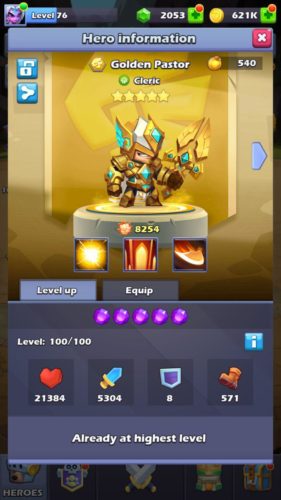
The main characteristics of the heroes: the amount of life, attack, defense and speed
Fights go on without interference from the player. Most of them take place offline (including when the player does not enter the project). Upon returning, the user is informed about the resources collected during his absence and the items obtained.
Progress within the campaign proceeds in a similar way to Tap Titans. With the victory of several waves of opponents, the party of heroes must fight with a conditional boss (a pumped party of opponents). The battle with him also takes place in automatic mode, but requires activation by the player.
Bosses are the main tool that encourages users to pump the deck. With their help, developers slow down the player’s progress, because for their victory it is necessary to accumulate and spend consumables for upgrading heroes.
Killing an obstacle moves the squad to the next stage, where the user gets more from automatic combat per unit of time.
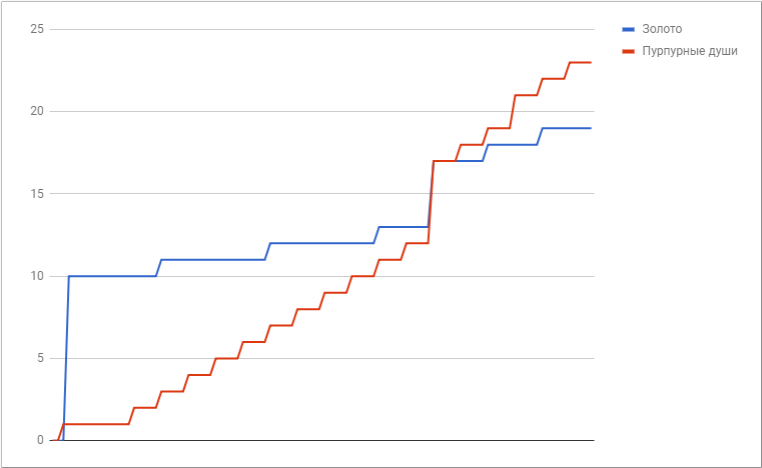
The dynamics of the growth of automatic earnings of gold and purple souls from level to level (the first 80 levels, about three weeks of play)
Also, depending on the stage, the type of loot obtained depends, which we will talk about a little later in the discussion of crafting.
Meta and economics of the game
The binding of the main gameplay, as well as its economy, are traditional for battlers. They are built on the management of the user collection and the player’s work with additional modes. And the deeper you dive into it, the more closely you work with it, the clearer it becomes that the economy of role-playing clickers is formal here and has any meaning only within the first hours of the game.
Collecting
The player’s battle squad consists of heroes. A set of heroes is a collectible. There are several ways to get heroes (collecting fragments, buying with game currency, winning at roulette, receiving as a reward for regular play, and so on). The main tool for obtaining gers is the local gacha.
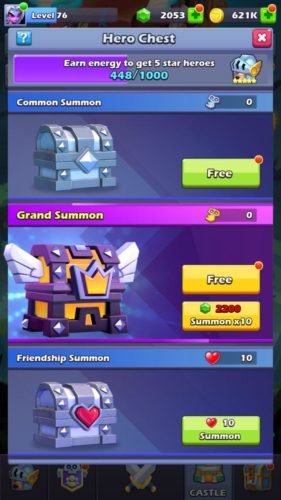
Local gacha
There are three types of chests in the game: regular, large and friendly. The first two open for free a limited number of times a day. In addition, they can be opened for keys, which are either purchased in the store, or are obtained as loot or encouragement. A large chest can also be opened directly for in-game currency. Friendly is opened for activity within the social mode of the game.
Features of the game balance is that the game is loyal to the non-paying player. She does not skimp on five-star heroes, which in any other similar game are given out only after a long grind or significant sums spent on gacha.

Heroes on five stars definitely do not make the impression of rare
This cannot but please the players, but it has a negative impact on the economy of the game. Due to the fact that powerful heroes quickly become available, the value of the rest decreases almost instantly for the player. They are not even perceived as meat. They seem absolutely superfluous.
In classic battlers, as a rule, they act differently. There are two traditional and often working together scenarios.
The first is to delay as much as possible the moment when the player is given powerful heroes. The player is forced to first assemble a squad of two- or three-star heroes, spend time and money on their buildup, so that later he can move on to work with rarer entities.
The second tool, which is also very popular, is the use of heroes as the main resource for pumping other heroes. This creates a constant shortage of them, forcing them to take seriously not only the choice of whom to pump, but also by whom.
In Taptap Heroes, the latter is present as a separate mode, which almost does not involve cards whose rarity is less than four stars. In fact, it only reinforces the above problem, since it further simplifies the production of rare five-star heroes.
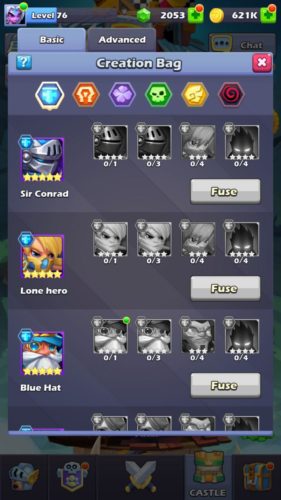
Here you can make five-star heroes out of not very rare ones
A situation is created when strong cards are almost immediately available, and weak ones turn out to be for show. This increases the speed of content consumption and reduces the LTV of the project, since when building a less steep curve of the speed of progress, the developer would have the opportunity, as indicated just above, to first earn on the buildup of a low-level squad of heroes.
Leveling up characters
The speed of progress in the game is exclusively tied to the strength of the squad. Since rare heroes in the game are relatively easy to get and are not very rare, the logical solution was to complicate their upgrade as much as possible. This was done with the introduction of three mandatory currencies for pumping heroes (gold, as well as purple and golden souls). This made it possible to create a triple shortage of resources at once.
We will talk in detail about currencies a little below, but now I will note that to raise each level in the game, two resources are required (the universal soft currency inside the game is gold and purple souls used only for pumping), earned and spent at different rates.
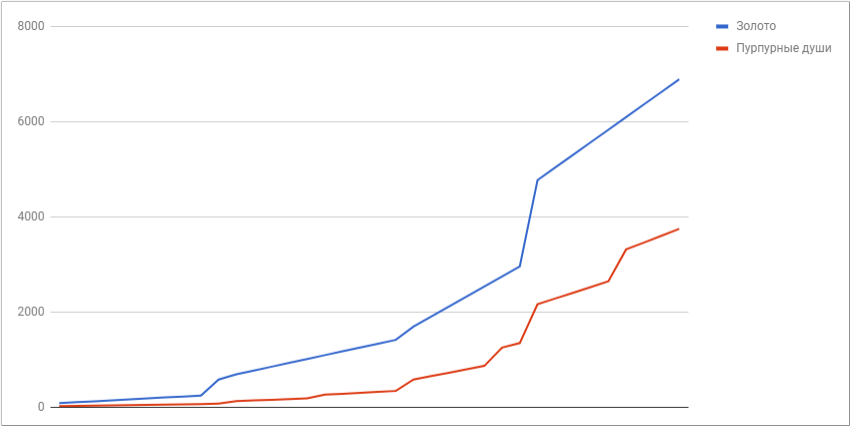
Price dynamics for raising hero levels (gold and purple souls, the first 50 levels)
The hero can be pumped with gold and purple souls only up to a certain level. Then, for further progress, it is necessary to raise his rank in order to be able to raise his levels further. To remove the level cap restriction (for each hero it must be done several times), the third type of resources is spent — golden souls.
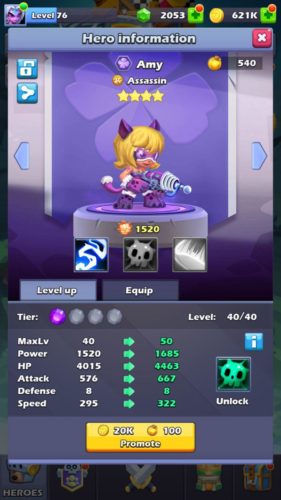
Between the usual pumping, they still need to spend golden souls
They are the hardest to get. Their shortage is felt regularly. It is equally relevant, both at the beginning of the game, and for already noticeably pumped decks. It forces you to choose heroes for pumping with great care.
But the balance in the game is built in such a way that at high levels of the game, the main deficit is not additional currencies, but gold, the need for which is growing exponentially for pumping, and which is actively used in other modes.
Pumping equipment
In addition to pumping heroes, their equipment is being pumped, which from the point of view of logic is very simple and mainly affects only one resource (the main soft currency is gold), but at the same time actively stimulates the grind, which is the main source of equipment.
One or another type of items drops out from each stage. If there is a need for this or that thing, this is just the factor that makes you sacrifice high earnings at a higher stage and return for the thing to an earlier one.
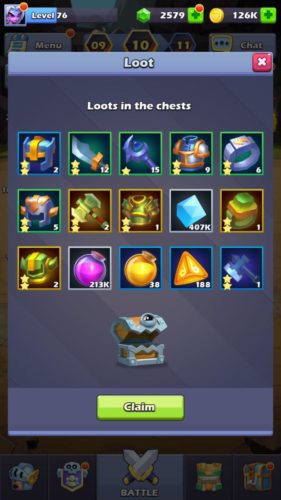
Here’s what falls out during the automatic game in addition to gold
Things differ in type and value (roughly speaking, there are swords, and the swords themselves can be made of obsidian, mithril and a dozen other materials). The more valuable the equipment, the higher their characteristics.
The game has a forge. With its help, you can improve the value of items. Each next item in strength, in addition to a certain amount, requires three copies of the previous one to be created. It works approximately as follows: the player receives, for example, three helmets with one asterisk at the location. He goes to the forge and collects one helmet with two stars from them.
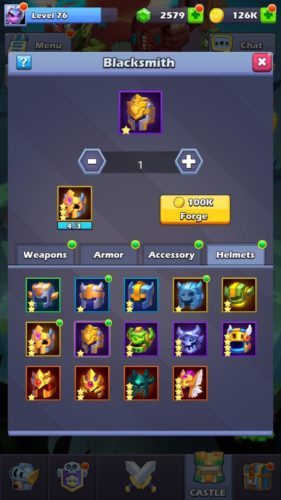
Blacksmith Shop
There are many types of items, they don’t fall out very often, and each new upgrade requires more and more amounts and more and more items of a specific type.
Due to the fact that they greatly affect the characteristics and give a bonus when collecting a collection (as, for example, it was in the Heroes of Might and Magic series), working with them turns into an important component. A game within a game that forces you to plan separately on which stage to send a squad, how much you will need to save, and so on.
This is a simple crafting mechanic that serves as a good motivating factor for making an additional gaming session.
Working with game currencies
As part of this chapter, we return to currencies. The game has two main currencies, two for pumping heroes and about ten additional ones.
The main soft currency is gold, the hard currency is emeralds. We have already stopped at the currency for pumping. As for the additional ones, they mostly get for participating in game modes (we will not stop at individual currencies for additional pumping of heroes and familiars).
With such a variety of currency entities in the project, the possibilities of transferring one currency into another are very limited. There is only one direct converter in the game — from emeralds to gold.
Since the lack of gold is minimal during the first time of the game, it suggests that Taptap Heroes is primarily aimed at monetizing those who faced a severe shortage of gold at the later stages of the game, that is, at their most loyal base, those who have gained a foothold in the game. And this is a significant disadvantage of monetization. The largest number of purchases is made in mobile, as a rule, in the first day. And it is the fresh players who are most prone to emotional spending, and they, in addition to expensive VIP modes, have nothing to offer the game.
There are no other direct converters in the game. To buy resources for pumping heroes, you will have to use a separate in-game store, which requires the use of hard currency to work effectively. The bottom line is that only a limited number of resources or items can be purchased in the store for a certain time. Moreover, it is possible that at a particular moment they will not be on display. However, there is a button that allows you to update trading positions for a small amount of emeralds.

If you want a larger assortment, pay emeralds
If a player needs, for example, purple souls, then he buys premium currency, goes to the store, looks for the required position. If it is not on display, he spends premium currency on updating the assortment. Then he buys it for some resource, it can be both the same emeralds and gold. The problem is that the number of purple souls available for purchase will be small. Therefore, as a rule, the player is forced to update the contents of the showcase once again, having already spent a substantial amount of premium currency.
This is an interesting solution that stimulates the consumption of emeralds. However, he has one fundamental problem — it is inconvenient to use this store. Moreover, it is possible that the player will not be able to detect this possibility at all. From the character’s screen, for example, you can’t go into it, the game simply reports that there is no required resource. Therefore, the player is forced to close the hero leveling screen, close the screen with a list of heroes, click on the button with a list of modes, scroll up and click on the store. Only after that he will be able to proceed to the purchase.
As for other currencies, they are one of the incentives to participate in additional regimes. For a winning game session in some modes, the player receives additional currency in addition to gold and pumping resources. For example, for a roulette turn, a player receives coins of luck. Participation in the life of the guild gives coins to the guild. Additional currencies are spent mainly on heroes or consumables.
The advantage of the fact that such a system does not have a single converter for all currencies is the simplicity of its balance. If the currencies were more closely related to each other, any change in the balance sheet would affect all its components, which means it would require more attention and adjustment.
Modes
Additional game modes are a common practice in battlers. They try to monetize the player outside of the main cycle, and also work to increase his session. There are six such modes/mechanics in Taptap Heroes.
— Roulette
Classic roulette with two monetization funnels. The player can spend money both to buy tokens for the game and to upgrade the playing field.

Roulette
— Arena
An uncomplicated PvP mode in which players compete for places in the ranking. It is monetized by the purchase of combat tickets by the player, just allowing them to fight with other players’ squads.

Arena
— Lair of secrets
It consists of many floors. One floor — one squad of monsters. For winning, they give access to a higher floor and one of the additional resources. The mode is not monetized. It is aimed at increasing the length of the session and helping the player with a set of resources for pumping in the first stages of the game (this is the main source of golden souls for the player in the first week).

Lair of secrets
— Tavern
A collection of changing quests that require specific types of heroes to complete and last from one hour. Works for retention and engagement. The main disadvantage is the lack of significant awards.
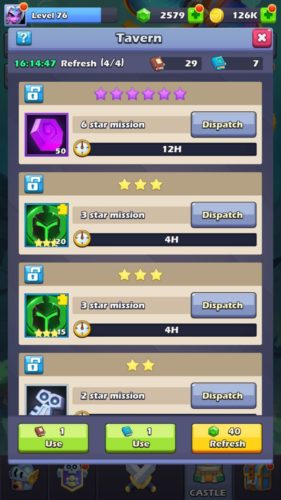
Tavern
— Expedition
A mode in which the user’s squad has to go through several battles without restoring health. This is one of the gameplays that awards the player with additional currency in relatively significant amounts, allowing you to start buying five-star heroes fairly quickly.
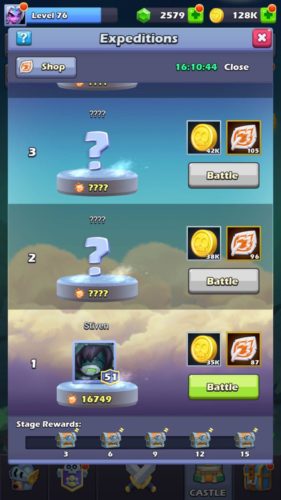
Expedition
— Guilds
A separate social regime, which is a constant source of gold and a separate additional resource.
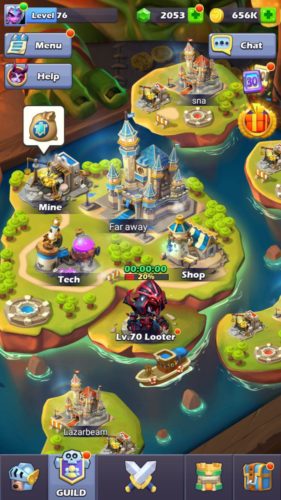
Guild Mode
The modes do not interact with each other, as they do not affect the campaign or the overall progress. They are all perceived together as a certain superstructure that helps in terms of accumulating resources and killing time.
Daily quests
The daily task pool plays the traditional role of retaining users. For most minor actions, the player is rewarded with resources every day. The game also publishes a list of bonuses for 30 days ahead that the player will receive for entering the game on each new day.

Quests
Elements of the clicker economy
The traditional clicker economy boils down to a simple cycle: the player builds more and more entities that generate currency in order to earn new entities that can generate currency even faster. This cycle is the main source of soft currency. Everything revolves around him.
Formally, this is exactly what happens in Taptap Heroes. The steeper the player’s squad, the further he has gone, the more currency the user receives per unit of time. However, there are two points that fundamentally overturn the system.
First, there is a limiter in the game for automatic currency collection. If in other clickers the player comes after ten days of absence and receives the resources collected during all this time, then in Taptap Heroes he receives only funds and items for the first eight hours of absence.
Secondly, at high levels, the amount of collected currency relative to the increased needs is quite small. The amount that his heroes will collect for the player in eight hours will not be enough even for their minimal upgrade.
So it turns out that the entire clicker economy turns out to be fictitious, used exclusively to involve the player. This decision can be easily understood both from the point of view of game design and from the point of view of marketing.
A real synthesis of economies would lead to unpredictable difficulties with the balance. The implemented step made it possible to immediately abandon radical experiments and bring a new audience.
Additional thoughts on synthesis
After almost three weeks of playing Taptap Heroes, I came to the conclusion that Taptap Heroes did two fundamentally important things as a hybrid. Within the framework of his genres, he showed that it is possible to move away from things that these genres no longer need in a good way and focused the players’ attention on the most important thing.
Irritation
Clickers, no matter how far they go from “Cookies” within the genre, still force the player to actively tap on the screen in the first sessions, earn the first currency. Then, as a rule, the need for frenzied tapping on the screen disappears and the main thing comes — gathering.
Battlers have a similar problem. The main gameplay loses its value simultaneously with the player’s progress. That’s just unlike the clicker, it still forces users to turn to it over and over again.
There is almost no first or second in Taptap Heroes.
The player can tap, and from level 70 he even has his own animal, which strengthens the blow, but this is as optional as possible and does not affect the gameplay.

Animal
As for the fights, the mandatory ones are only those that are necessary to move to a new level. There are relatively few of them. Those that relate to modes can be skipped for free.
Pleasure
One of the central pleasures of clickers is constant bonuses and accumulation. The player is pleased to enter the project, in which he is immediately informed that he has earned something, collected some things. This genre stimulates our cognitive component, which always wants a gift. This genre is by and large about pleasure. And it’s in Taptap Heroes in place.
The main feature of the battlers is pumping and deck management. The player gets pleasure from messing with the heroes, from counting their characteristics, from spending game funds to improve them. This, as could be understood from the things described above, in Taptap Heroes, was transferred as is.
***
Due to the fact that they removed the irritation, but left the pleasure, the game is very pleasantly perceived, although it quickly becomes clear that it is not designed for a very long time.